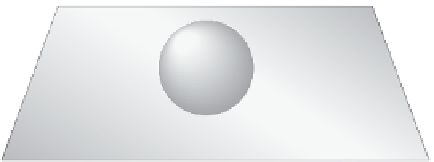Graphics Reference
In-Depth Information
Approximation sphere
L
Figure 2.13
Radiance estimation from a photon map comes from a averaging a specific number of pho-
tons near the sample point, but limited to a fixed approximation sphere. (After [Jensen 96].)
There is also a difference between photon mapping for caustics and global il-
lumination in the rendering stage. In global photon mapping, the photon compu-
tation is not done at every point to be shaded. Rather, the lighting computation is
done in the usual MCRT manner of sampling over light sources. The photon map
can be used to approximate the irradiance and determine the appropriate number
of samples. It can be used in a similar way for importance sampling: the distri-
bution of photons represents the relative importance of incoming light directions
and can be used to guide the choice of directions to shoot reflected rays.
2.4.4 Improving Photon Mapping
Constructing photon maps is computationally expensive. Theoretically, an infinite
number of photons is necessary to obtain accurate results (just as infinitely many
rays are theoretically needed for Monte Carlo ray tracing). In practice, though, it
is only necessary to shoot the minimum number of photons needed to get adequate
visual quality. One improvement is to introduce a more principled method for
shooting photons from the light instead of just firing in random directions. The
same techniques used to improve Monte Carlo sampling, such as stratification or
a quasi-Monte Carlo approach, can lead to a more even distribution from fewer
photons.
In real environments, light is typically concentrated in particular parts of the
scene. Furthermore, not all surfaces of a scene are visible from a particular view-
point; examples include back-facing walls, undersides of tables, objects behind
the camera, etc. These surfaces contribute to global illumination, but only through
reflection. A coarser photon representation may suffice for that. Ingmar Peter and
Georg Pietrek proposed adding a kind of dual precomputation to Jensen's photon
mapping algorithm that fires imaginary particles known as
importons
from the
viewpoint [Peter and Pietrek 98]. Importons are stored in an
importon map
in
the same manner as a photon map, but they travel in the opposite direction. The




























































































